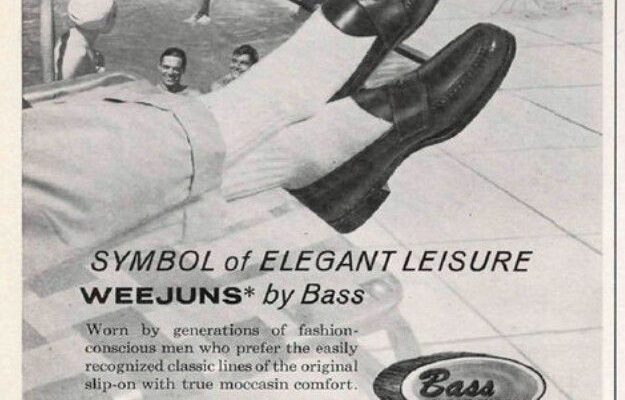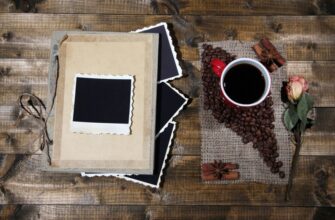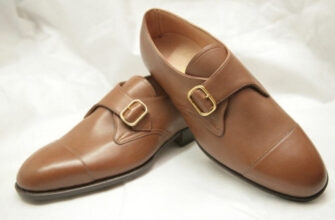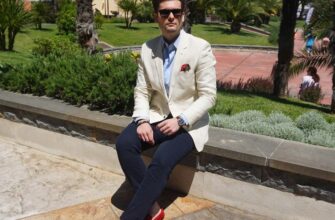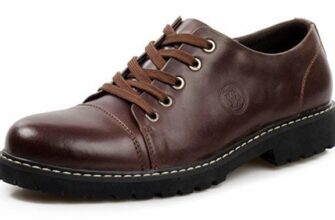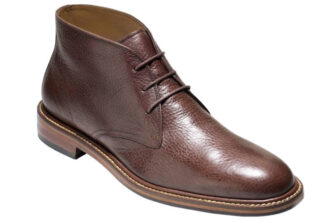Continuing a series of articles on classic and casual shoes, one cannot fail to mention loafers. In the article where we looked at moccasins, we already mentioned loafers. They are similar to moccasins, however there are differences. What are these differences, where did the loafers' shoes come from and what is appropriate to wear them with – the topic of today's article.
Loafers revolutionized the fashion world in the early 20th century. By pairing shoes with chinos or even dress pants, loafers become an essential element of the semi-formal dress code for the spring / summer season. Yes – yes, you are not mistaken. Loafers are quite appropriate to wear with a classic suit and in this form you can go to business meetings or negotiations.
Loafers history
Unlike other types of shoes, loafers have several theories of origin. Some are even convinced that loafers evolved from moccasins. But this is not the case. There are 2 of the most popular and most reliable origin theories:
- loafers appeared in Norway when local shoemakers combined traditional Indian shoes with Norwegian traditional shoes;
- second theory: loafers were invented in England, where they were used as 'house shoes'.
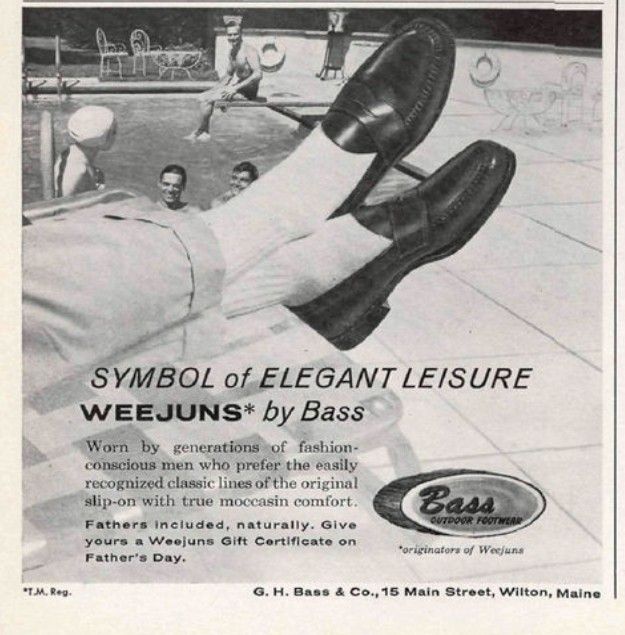 Weejuns ad from 1962's – a symbol of elegance
Weejuns ad from 1962's – a symbol of elegance
While it is difficult to pinpoint where loafers actually came from, the further history and evolution of these shoes over time is interesting. First of all, we will look at how loafers are characteristic, and only then we will look at the different models that were invented by fashion houses in different countries of the world.
What are the characteristics of loafers
In order to clearly separate loafers from other shoes, the following qualities are necessary:
- Lack of laces.
- Low shoes, i.e. the top edge is always at the ankle level.
- There is a separate sole.
- The presence of a small heel.
- The tops of the loafers are very similar to the moccasins.
- Decorative elements on the upper part of loafers: tassels, a kind of horse bridle (a signature feature of the Gucci brand), leather patches.
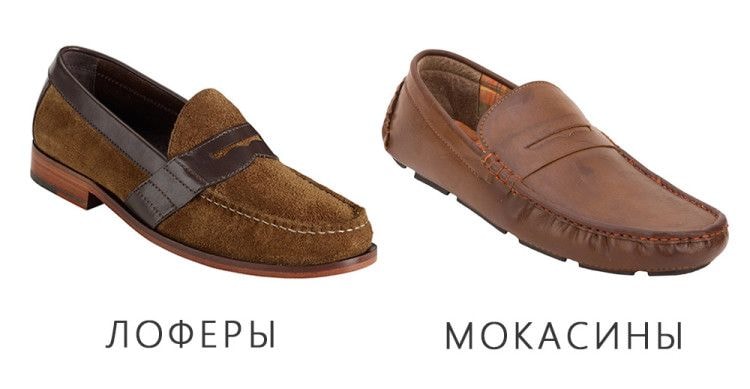 Key differences between moccasins and loafers
Key differences between moccasins and loafers
As you may have noticed, loafers are very similar to moccasins. Sometimes they can be so similar that if you look at the shoes from top to bottom at a distance of 2 meters, you will not find them different.
Key differences between moccasins and loafers
There are several key differences between loafers and moccasins:
- All loafers have a separately sewn / glued sole. Moccasins may not have it at all.
- Loafers have at least a small heel. Moccasins don't have a heel.
- Unlike moccasins, loafers are almost devoid of embellishments. Exception: tassels and metal bridle, leather stripes.
Loafers from Wildsmith
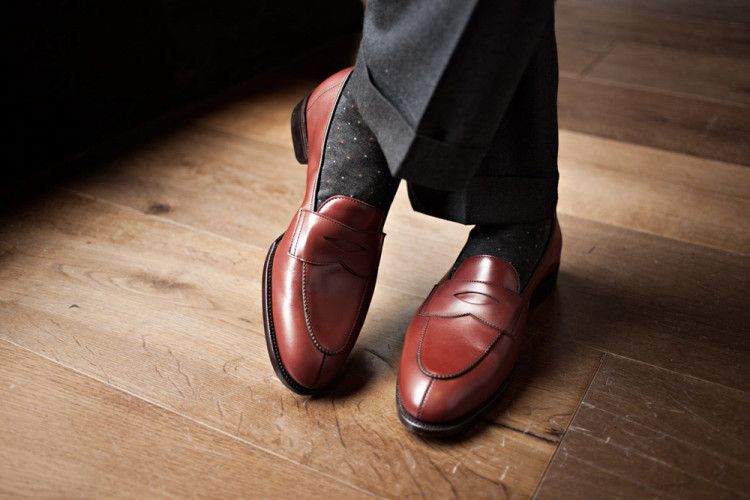 Wildsmith Loafers
Wildsmith Loafers
The English company Wildsmith was founded in 1847 by Matthew and Rebecca Wildsmith. Handmade footwear is rightfully considered a hi-end class and the basis of its activity is the manufacture of boots for horse cavalry at the court of the United Kingdom of Great Britain.
In 1926, the grandson of Matthew and Rebecca, Raymond Lewis, received an order from King George VI for shoes for a country house. By order of the king, the shoes were supposed to be comfortable for moving around the house. Raymond came up with a shoe with a small heel, and a comfortable cut on the top, so that it was easy to put on and take off. Laces were not used in the model. The shoe construction was very similar to moccasins. It is not known whether the design was invented by the shoemaker himself or the king himself dictated the shape to him. However, a shoe model was made and named # 582, and later 'Model 98'. Today this loafer model is simply called the 'Wildsmith Loafer'.
Despite the fact that the shoes were originally conceived as shoes for the home, they began to be used as casual shoes for walking on the street.
Aurland Loafers
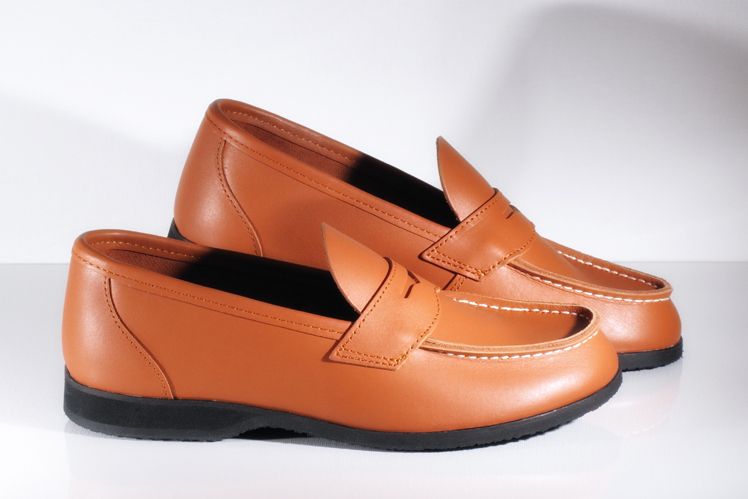 Aurland Loafers
Aurland Loafers
At the beginning of the 20th century, the shoemaker's son Nils Gregory Tverenger presented his loafers at a shoe exhibition in Aurland, Norway. Niels left for North America at the age of 13 to learn the art of shoe making and spent about 7 years there. In 1930 he introduced a new heel shoe design, which was later named 'Aurland moccasin'. These shoes were highly acclaimed by local fishermen, who happily wore them when they went fishing in the town of Aurland.
Slowly but surely, moccasins from Aurland spread throughout Europe and became quite popular. At that time, American tourists were frequenting Europe and one of them noticed heeled moccasins. It turned out to be the editor of Esquire magazine, who brought moccasins to America. In 1930-1933. a family of businessmen from New Hampshire (America), started the production of moccasins from Aurland and gave them the familiar name 'Loafers', which was closer in spirit to the Americans.
Penny loafers
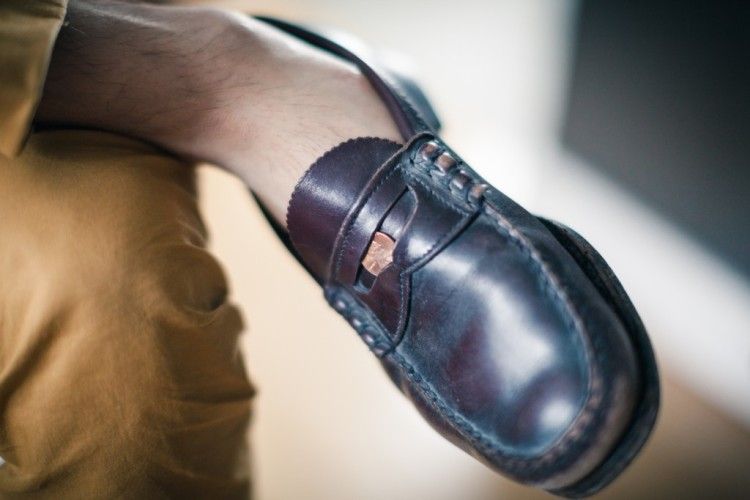 Penny loafers
Penny loafers
In 1934-1936. footwear company G.H.Bass presented its version of loafers to the world, which is still popular today. A piece of leather with a diamond cut was sewn into the top of the boot. The models were named 'Weejuns'. They became very popular in America, especially among applicants in the 50s. At the time, loafers were nicknamed 'Penny Loafer'. According to one theory, the shoes began to be called that because a coin could be inserted into a Penny in a diamond-shaped cut. Whether it is true or not, the name stuck for many years and 'Penny Loafers' have become a real classic.
Tassel loafers (with tassel)
 Tassel loafers
Tassel loafers
It is not known exactly who first came up with the idea of decorating loafers with a tassel. However, it is known that after the Second World War, the American film actor Paul Lucas brought from abroad low shoes with decorative tassels on them. While in New York, he donated shoes to Farkas & Kovacs and asked them to do something similar for him. The craftsmen could not make a model that would satisfy the actor, and he transferred the pair to other shoe companies: Lefcourt of New York and Morris Bookmakers, which were located in the famous Beverly Hills. Ironically, both companies simultaneously, without a word, sent the loafers model to another company called The Alden Shoe Co., where the final model was finally implemented, which Paul Lucas liked. For a long time, the model was subjected to experiments and by the 1950s tassel loafers were widely accepted among the residents of New York and Los Angeles (USA).
Loafers by Gucci
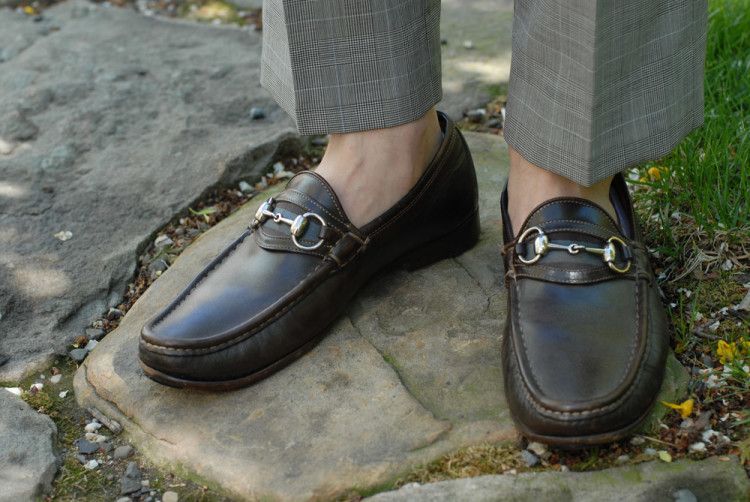 Loafers by Gucci
Loafers by Gucci
While loafers are confidently gaining popularity in the United States, where it was already appropriate to wear a pair with a business suit in the 60s, a different situation is happening in Europe. In Italy, where loafers were most widespread, people perceived shoes as home shoes and did not intend to wear them with a classic suit. But that all changed in 1968 when the famous Gucci designer introduced loafers with a gilded accessory, which was a snaffle – one of the details of a horse bridle.
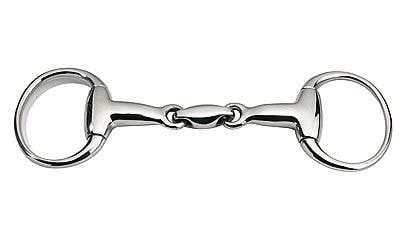 Snaffle – detail of the bridle, which began to adorn loafers from Gucci
Snaffle – detail of the bridle, which began to adorn loafers from Gucci
5 years before the maestro's model was invented, Gucci opened an office in New York, where he actually drew attention to the popularity of loafers. Gucci has tweaked the regular loafers a bit, added a bit and made the classic black shoe. At that time, loafers were made in different colors, as shoes were considered casual style. As a result, Gucci did its best to make the shoe look like a classic one, and it would be appropriate to wear it with a suit even in New York. His idea worked.
Gianni Agnelli – Italian entrepreneur, main shareholder and CEO of FIAT; John F. Kennedy – American politician, 35th President of the United States – these and many others have enjoyed wearing Gucci loafers. In 1969, Gucci sold 84,000 pairs of shoes in the United States in its stores alone. By the 70s of the XX century, Gucci loafers were firmly established in the wardrobes of business people and entrepreneurs who lived on Wall Street.
Since 1985, Gucci loafers have been honored to be part of the permanent exhibit at the Metropolitan Museum of Art in New York.
How to choose loafers
Loafers are shoes that sit between the worlds of classic and casual. Loafers will never be completely businesslike due to their heritage, but they can be perfectly suited as home slippers.
For example, Gucci loafers can be paired with a variety of clothing. Shoes made of dark, smooth leather are perfect for a classic suit. Loafers in light colors, suede or just thin leather will be appropriate to wear with chinos or even shorts below the knee.
Tassel loafers are less formal than Gucci loafers. It is most appropriate to wear shoes with tassels under corduroy or woolen trousers in combination with a tweed or sports jacket (blazer). Tassel loafers are a great option for a business casual style, where a little more freedom of choice in colors, shapes and materials is allowed than in a business style. Try wearing tassel loafers, dress pants, a shirt, and a navy blazer on top. I am sure you will enjoy the combination of still business style and comfort.
Penny loafers are a great addition to corduroy pants, chinos, and even flannel pants. In terms of formality, Penny loafers are less formal than tassel loafers. Perfect for smart casual and business casual dress code, where the look can be complemented with a classic shirt, tie or bow tie.
If you prefer a casual style, then Penny loafers are also appropriate here, but it is customary to wear them without socks, unlike, for example, top-siders. Loafers are great for shorts, especially when walking in the hot season.
Lookbook with loafers
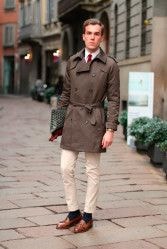 Tassel loafers in brown leather paired with chinos and trench coat
Tassel loafers in brown leather paired with chinos and trench coat 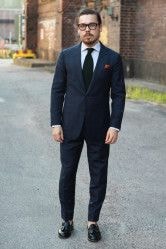 Tassel loafers paired with a classic suit
Tassel loafers paired with a classic suit 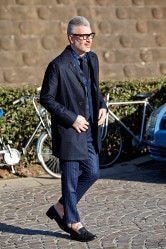 Tassel loafers paired with a classic suit and coat
Tassel loafers paired with a classic suit and coat 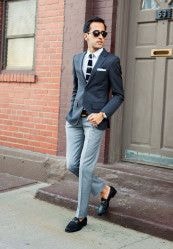 Loafers by Gucci paired with gray wool pants and a charcoal blazer
Loafers by Gucci paired with gray wool pants and a charcoal blazer 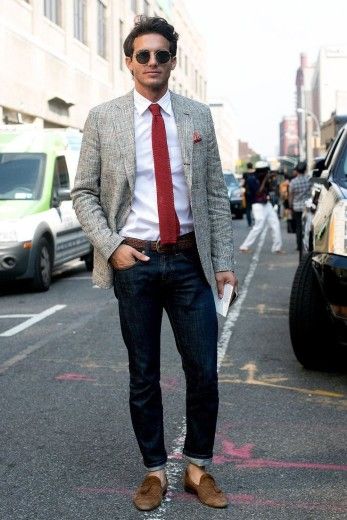 Tassel loafers in suede paired with jeans and a blazer
Tassel loafers in suede paired with jeans and a blazer 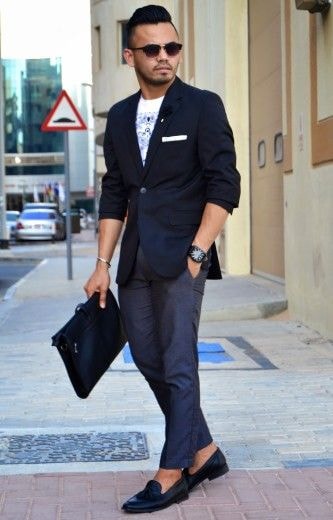 Wildsmith Loafers in black leather paired with cotton pants and a blazer
Wildsmith Loafers in black leather paired with cotton pants and a blazer
Finally
Every man should get at least one pair of loafers and feel comfortable, even on long journeys. Pay attention to business people at airports who are often on business trips. Many of them are wearing loafers. This is not so much a tribute to fashion as a great solution for a business look combined with comfort.
If you are going to the sea, where you are supposed to go to a restaurant after walking, loafers are the best fit for you. It is inappropriate to go to a good restaurant in sandals or slippers, and very even in light-colored loafers.
Assess your needs and be sure to go to the store. I am sure you will look at loafers with different eyes after reading this article. All the best and a great tourist season!

